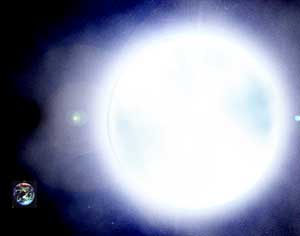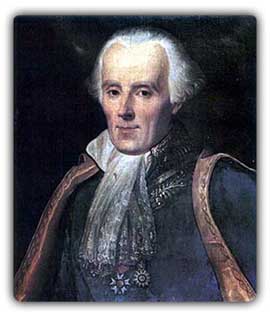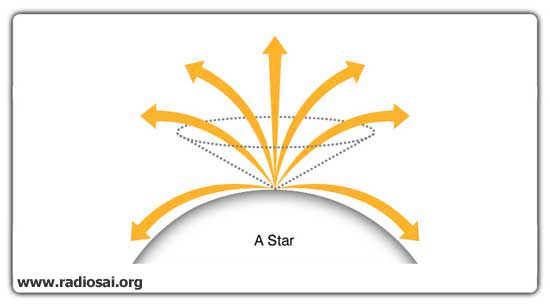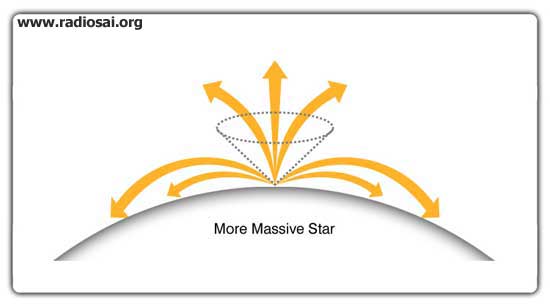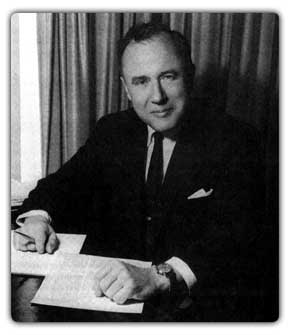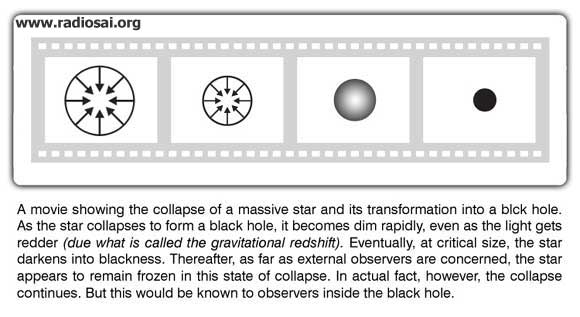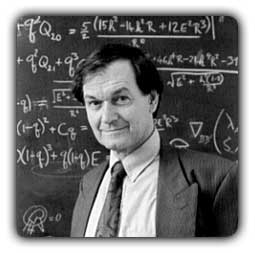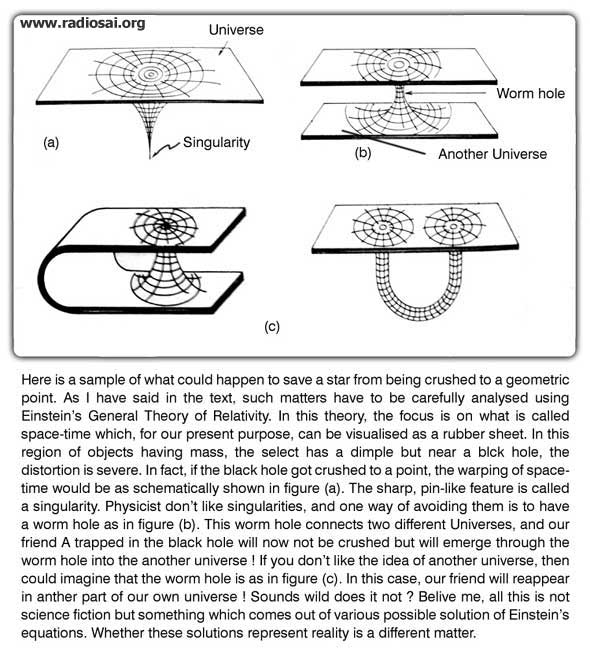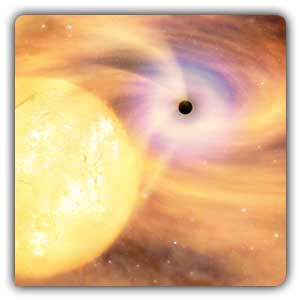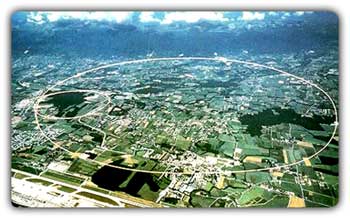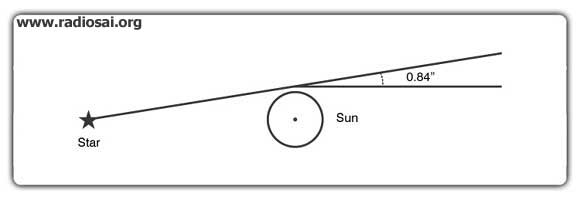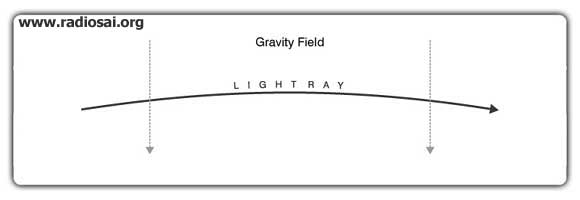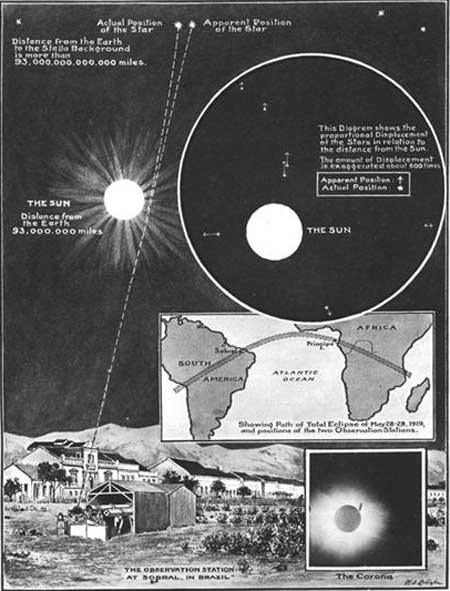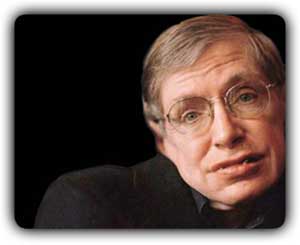 |
 |
 |
Volume
5 - Issue 05
MAY 2007 |
|
THE MYSTERIOUS BLACK HOLES Loving Sai Ram and greetings. In America while describing things extra-ordinary they sometimes say, “You ain’t seen nothin’ yet!” That very much holds true now, for you really must hold on to your seat as you get ready for what is to follow. In other words, I am now going to introduce you to exotic astrophysical objects called the Black Hole. The funny thing about Black Holes is that they cannot be directly seen; indeed no instrument can be designed to enable man to directly see them, like one can see galaxies and stars. And yet, all astronomers and astrophysicists would swear that black holes do exist! Yes, sometimes truth is indeed stranger than fiction. So, get ready to hear something that might sound like pure spin but is actually God’s truth!
Before we start talking about Black Holes, we must briefly recap what we already know about White Dwarfs and Neutron Stars, which we discussed in the two earlier issues of H2H. If you recall, they both deal with the fate of stars that have ceased thermo-nuclear burning and start collapsing and shrinking due to the relentless force of gravity. We learnt that depending on the mass of the progenitor star, there are actually three different endpoints, with of course three different associated scenarios. For stars having relatively “low” masses, the endpoint is a White Dwarf. Next in order is the neutron star, and the last of this trio is the black hole, the subject of our present discussion. You might, by the way, look up the table I gave towards the end of the last article. OK, so we have a defunct star, a progenitor star in our current jargon, with a mass exceeding say 15 solar mass. This star has ceased thermo-nuclear burning and has started collapsing. First on the way, the electrons try to stop the collapse by invoking electron degeneracy pressure but they are not able to; they therefore quit. Next, the neutrons try to put up a defence, but they too are unable to, this time because the mass of the progenitor is just too much; gravity relentlessly crushes the star more and more. What happens now? That’s what we shall now consider.
Crucial to understanding the existence of black holes is the fact that light can be affected by gravity. Soon after Newton came up with his discovery of the force of gravity, people believed that light could be affected by gravity. Accepting this view, in the year 1784, geologist John Mitchell in England suggested that if there was an object sufficiently massive and if it had the right size, then its gravitational force would be so strong that light emerging from its surface would be pulled back; indeed, it could not escape. Mitchell’s idea is simple really. Suppose you throw a stone up; you know what would happen; it falls down, and that is why it is sometimes said that what goes up must come down. Not always! You see, it all depends on the velocity with which the stone is thrown up. If this velocity is sufficiently high, then the object thrown up could actually escape from the earth. The minimum velocity needed for this is known as the escape velocity and even high school students these days know that it is about 11.2 km/sec. This fact is made use of by rocket scientists who want to send spacecrafts to the Moon, Mars, and so on. What Mitchell said was: “Listen. If this object is just right, then the force with which it pulls light can be so high that light emitted from its surface could not escape!” I should add that Mitchell believed, as suggested by Newton, that light was made up of particles [which therefore had mass]. Developing this idea, Mitchell wrote a paper that he sent to the then reputed scientist Cavendish for publication by the Royal Society of London. In that paper, Mitchell said:
In 1796, Laplace in France promoted the same idea but it did not receive such notice because by this time, the idea that light was made up of particles was replaced by the theory that light was actually made up of waves; and in the wave theory of light, light had no business to be pulled by gravity. So the idea of Laplace went up like a lead balloon as they say, and everyone forgot about these two people, Laplace and Mitchell. Things remained like that for over a hundred years, until Einstein came up with his famous theory of gravitation in 1915. This was revolutionary and not only supplanted Newton’s theory but introduced many daring new concepts. The most stunning one was that light could be deflected by gravitational pull. The story of how scientists detected the bending of light is an exciting one in itself, featuring by the way, Eddington whom you have met earlier. This story is told separately, partly because it is important and partly because it was this sensational discovery that gave Einstein almost a rock-star status! Getting back to the main point, you might wonder: “Listen. Now Einstein’s theory of gravitation is a classical theory; therefore there is no scope for light to have a dual status, namely as a particle and as a wave, a status that quantum mechanics confers [more about that in a later issue]. In classical theory, light is believed to be a wave, an electromagnetic wave in fact, as asserted by Maxwell, and as proved by so many experiments. Then how come a wave gets deflected by gravity, when that idea was rejected earlier?” Good question! You see, what Einstein’s theory said was that space gets warped when matter is present.
And when light travels through warped space, it would get bent! That is how gravity affects light in Einstein’s theory of general relativity. The rest of the story of how this incredible prediction was verified is presented separately. [See end of this article or click here for Eddington story]. Let us move on and see what special things happen when a progenitor with a mass of the order of say 15 solar mass starts contracting due to gravitational crush. As I told you earlier, first the electrons try to put up some resistance; they fail and then quit. It is then the turn of the neutrons; they too fail and they too quit. What happens now? Ah, that is where the story becomes interesting and in its later stages perhaps even weird! Consider light rays emerging from a point on the surface of an object of the type we are considering. Because of gravitational pull, the object will try to pull back the light, even as it tries to escape. Because of the pull, the light will “fall”. For rays that are emitted nearly parallel to the surface of the star, they will end up falling back to the surface of the star. With a little bit of thinking, you can easily see that there would be a cone; light emitted inside this cone would escape while light emitted from outside the cone would fall back to the surface. This cone is called the exit cone.
Above we have a star, and have drawn the path of light rays being emitted from a point on the surface. As we know, the light will be attracted by the mass of the star. For rays that are emitted nearly parallel to the surface of the star, they will end up falling back to the surface of the star. We have drawn an exit cone; light emitted inside the cone escapes from the star, and light emitted outside the cone falls back to the star.
Keep this important fact in mind and let us follow through the scenario as the object under consideration shrinks to a smaller and smaller size. Now the mass of the shrinking object obviously remains the same throughout, but because the radius gets smaller and smaller, pull due to gravity at the surface becomes stronger and stronger, as the radius stands becoming smaller. This means that at some radius, the exit cone simply shrinks away; which means that all light rays leaving the surface, HAVE to fall back. In other words, no light can escape from this object. That is the important point I have been trying to get to, and it is an important point by the way. Please note, this can happen only when the progenitor star has a large enough mass; even for such an object, the exit cone does not vanish right away; it does so only when the radius becomes sufficiently small, as to make gravity really powerful and supreme. The radius of the object when the exit cone just vanishes is called Scwarzchild radius, after the scientist who first investigated this phenomenon. The outer boundary of such an object is called the event horizon.
Question: “What happens after the progenitor star shrinks to the Schwarzchild radius? Does the shrinking continue?” We think so and have no reason to believe that the shrinking process would stop. “Can we see it?” No! “Why not?” Simple! Light can no longer escape from that object and convey information to us, that is why! Which, incidentally is the reason why such an object is called a Black Hole. As should be obvious, an event horizon is associated with every black hole. By the way, the term black hole was first used by Professor John Wheeler in 1967; prior to that these objects were called dark stars. Let us continue with the “shrinking story” if I might call it that! The progenitor has just stopped sending light to the outside world and has shrouded itself with an event horizon. It is continuing to shrink – so we believe; no reason to believe otherwise. OK, what happens now? Does the shrinking go on forever? Obviously it cannot because at some point the object would have a radius of ZERO! What happens now? That zero radius business became the embarrassing part of the whole story. Physical objects have a finite size; this is true of all objects we know, from galaxies to atoms, nuclei and objects even smaller. If an object with a finite mass has zero size, then its density would be infinite, and physicists simply cannot accept that kind of situation. Infinite density represents what they call a singularity, and singularities [of any kind actually] simply horrifies physicists; they just can’t stand it! For example when working with his gravitational equations, Einstein discovered that the Universe might have had a beginning from “nothing”, he was simply shocked; that is because he could not accepted that God could have started off the Universe with singularity. I mention all this just to drive home the point that when we start imagining what might possibly be happening inside a black hole, we end up with a situation where there might be a singularity. But that is not allowed [!] and so a lot of debate went on about how Nature could circumvent the singularity and so on. Before I come to that, I would like to present for you an excerpt from a lecture that Prof Chandrasekhar gave in Ahmedabad many, many years ago. He began with a question and then continued as follows:
So we have lost our friend observer A! In practice of course, we cannot have an observer like A giving a running commentary. At best we can observe the star from here. Let us say we are looking through a telescope at massive star collapsing in this manner. Figure [below] shows schematically what one would see.
So what would an observer inside the black hole see? With our knowledge of physics, we can visualise what would happen to him. He would be subjected to what are called tidal forces. You must have heard of the high tide and the low tide on the seas, and how they arise. They are produced, for example, by the forces that the Moon exerts on the earth. Such forces would also act on our body due to the earth, and in principle, our bodies should also exhibit a stretching. Since our feet are closer to the earth than our head, the pull of the earth would be more on the feet than on the head. Essentially, we should be elongated a bit by the earth. In practice, this kind of elongation is negligible. However, for an observer inside the black hole, it is a different ball game. To start with, since the forces are very strong, the effects too would be dramatic, as the sketch [alongside/below] shows. Meanwhile, the object itself is collapsing which means that our friend is also moving closer and closer to the centre. Eventually when the object collapses into a geometric point, our friend too would vanish into nothingness!
This brings us back to the issue of singularity, and the question now is: “Can the black hole end up as a singularity?” As I told you earlier, singularity is a “bad” word in physics, and many people simply could not accept that the final fate of a black hole would be singularity; “that would be so unphysical”, they protested. In 1965, Roger Penrose, a brilliant English mathematician and Stephen Hawking [whom you have met earlier], carefully examined the entire issue of singularities within the framework of Einstein’s theory of general relativity [on which his theory of gravitation is based]. They then came to the conclusion that if the theory of general relativity is correct – and we believe it is so at the classical level – then singularities are inescapable. In turn, this means that the black hole must end in a singularity. Physicists were now caught in a quandary. Their gut feeling was that singularities had no place in physics; black holes simply could not end as singularities. On the other hand, Penrose and Hawking said, “We feel that way too but sorry. If you accept Einstein’s theory of general relativity to be correct and it sure is as of today, then singularity is inevitable.” This brought in the idea of “cosmic censorship!” I do not how it is in the movie business today but many years ago, we had a body called Censors. They would watch a movie before it is released to the public, and if they found some scenes that were, in their opinion, objectionable, then those scenes were simply cut off; that was censorship. People now said, “Listen, we really do not know what happens behind the event horizon. Who knows what really happens at the centre of a black hole when it becomes really small?” Thus, the event horizon was seen as some kind of a “cloth” that covered the undesirable scenario within the black hole! This is cosmic censorship!
Some years after Penrose and Hawking wrote their famous paper on singularities, Hawking examined the physics of black holes in another context, that of the entropy of the black hole. I do not want to go into all that technicality but the long and short of it is that Hawking had to invoke quantum mechanics to discuss that issue. So people now began to say, “Hey, wait a minute, maybe quantum mechanics can intervene and save the black hole from ending up in a singularity!” Apparently that is definitely possible, as seemed from Hawking’s work on the entropy of black holes. Physicists now began to heave a sigh of relief; and soon they began to argue, and with good reason too, that when one starts dealing with very small dimensions [as one has to do when considering a singularity], then classical physics would totally fail. In other words, the final state of a black hole simply cannot be discussed within the framework of Einstein’s [classical] theory of gravitation. Instead one would have to use a quantum version of it. A quantum theory of gravity is not available as yet, but people already know that space-time, which is the central aspect of theories of gravity, becomes spongy and discontinuous when one goes down to incredibly small distances, as one would have to, if one is to discuss singularities carefully. And at that stage, there might be no singularity after all! Meanwhile, other amazing scenarios have been visualised that could save a black hole from encountering a singularity. In this scenario, the focus is on space-time, the fabric that forms the background to the general theory of relativity. This space-time can be visualised as a rubber sheet with rectangular grid lines on it, with equal spacing. When we talk of such a rubber sheet, we can have two kinds, an unwarped one and a warped one. An unwarped rubber sheet corresponds to spacetime that has not been disturbed, while a warped one represents spacetime that has been disturbed. You have already been introduced to this idea before in the context of the famous light bending experiment of 1919. Here we pursue some other aspects of that warping, with particular reference to how a black hole could avoid a singularity. Suppose a black hole gets crushed to a geometric point, resulting in a singularity. In this case, the warping would be extreme as in figure (a). As I have told you, physicists do not like singularities and so they said, “Hey, wait a minute. May be when this extreme situation is approached, Nature would seek a way out as in figure (b). Here a we have what is called a worm hole which actually connects Two different universes! So if we have observer A who is falling to the centre of a black hole, he would actually slip through the worm hole and emerge in another Universe! Sounds like science fiction does it not? Indeed it does but these are some serious ideas that many cosmologists have studied mathematically! So, truth can indeed be stranger than fiction!
May be you do not like the idea of our observer A disappearing into an entirely new universe. No problem, we could keep him in our own universe through connectivities as in figures (c) and (d)! That is to say, our observer would vanish from one part of the universe and appear in another part. Worm holes have received some attention but in view of the fact that quantum gravity can offer a different bypass to [classical] singularity, one need not imagine that worm holes offer the only escape path. What you must understand is that there are remarkable mysteries in Nature the answers to which we would never know. But they are there for sure, and we must take time off to wonder about them. A few questions remain before I wrap up this instalment. First question: How many types of black holes are there, if at all? It turns out that one might recognise three basic types. The super black holes, the normal black holes, and the mini [or better micro] black holes. Thus far, I have been talking essentially about the “normal” black holes, which result when dead stars with a mass around say ten solar masses or so start shrinking due to gravity. The super black holes form an entirely different category. They are expected to have masses millions of times that of our Sun. Why on earth do we have to “invent” such huge black holes, and if such super massive black holes do exist, where do they hang out? Let me start with the first question first. It all started with the discovery of objects known as quasars. The word quasar is derived from QUASi-stellAR radio source, the name by which these strange objects were first called when discovered in the late 1950s. The discovery was made using large radio telescopes, which had just come into existence. No one knew what these objects were but two things became clear: 1) Whatever they were, they sure were emitting a large amount of energy, a HUGE amount really. 2) Spectroscopic evidence suggested that these objects, whatever they were, were moving at fantastic velocities, something like a significant fraction of the velocity of light. Now that meant that something was happening out there that could not only generate huge amounts of energy but also cause these objects to move with a terrific speed.
The whole thing was mind boggling, and people had to come up with a really good story that tied all the different scientific facts together. That happened years later, and the currently accepted hypothesis is that in the middle of many galaxies, active galaxies actually, there must super massive black holes that act as the engine that drives the quasars. I am of course giving only the headlines and that should not make you think that I am presenting just a bunch of vague speculations. Actually, there is a fair amount good reason to believe in this hypothesis; otherwise, scientists, who are usually sceptics where revolutionary ideas are concerned [and ever eager to shoot down theories they consider to be wild!] would not toy with the idea of super massive black holes acting as engines that drive the quasars. By the way, as of today over a hundred thousand quasars have been identified in the sky! Let us return to the “normal” black holes we started with, namely those resulting from the gravitational crushing of stellar corpses with a mass around 10 solar masses. How do we know they exist? Is there any observational proof? Well, if the question is posed that way, then it should be obvious that by its very nature the black hole is very “secretive” meaning it does not allow information to flow from with in or even its surface. OK, but is there really no way to catch a black hole? Fortunately, there is and that method exploits the fact that black holes can be greedy, very greedy in fact! You must thinking I am kidding; no I am not! What sometimes happens is the following. It could be that in the neighbourhood of the black hole, there is another object [read matter]. For example, we have what are called binary stars; they are twins that sort of go round each other. Suppose one of this binary becomes a black hole. The gravitational force of the black hole being enormous, it would start pulling material from the neighbourhood into itself. In other words, the “hungry” black hole would start sucking matter towards itself. In the process an accretion disc is formed.
OK, but anything like the smoking gun? That is not available yet but special detectors are being built that would one day provide incontrovertible proof for the existence of the black hole [whose existence is not in doubt]. What is the idea behind these detectors? Well, it is something like this: Black holes are not going to simply sit there and keep quiet; they would interact with other objects our there in space, via gravitational forces naturally. For example, one black hole might collide with another. Or we might have a situation where a black hole as just being born. Or else, it might be a case of black hole having its lunch! In every case, gravitational waves with characteristic signatures would be emitted. The details of these signatures can be worked out; today’s theory is smart enough to do that. Theory is smart, but what about the experimenters? Are they smart enough to detect these waves? Well, this is a tough job really but finally technology is getting so good that within a few years gravitational waves might actually be detected, almost a century after Einstein predicted that they exist. And, we could actually have very smart detectors hanging out in space which do the detection. Finally, we might have the smoking gun! Would cost a lot of money, would it not? Sure would; modern astronomy and astrophysics do not come cheap! We have thus far considered two types of black holes, the super massive and the normal. I have also briefly touched upon how black holes might be detected. What about the third type? These are sometimes called mini black holes and are incredibly small. How small? Oh it is difficult to say, but just to give you an idea I would say probably as small as an electron, which means really, really small!
How does one produce such mini black holes? Not easy, and as of now, there is only one lab in the world where this could possibly be done. And that is the CERN in Geneva, where, buried in the ground below is huge particle accelerator with a circumference of about 25 to 30 km! In this, electrons whiz around at the almost the speed of light, in the process crossing an international boundary between Switzerland and France! They do this millions of times every second. While electrons go round and round in circles one way, anti-electrons and positron similarly whirl around in the opposite direction. Naturally, they sometimes collide and when they do, all kinds of exciting things happen, which of course physicists study with great interest. Amazing things have been discovered in the process about which I shall say something later. Here I wish to say just this. Currently, this monstrous accelerator in Geneva is being upgraded so that instead of electrons and anti-electrons there would be protons and anti-protons going round. Now protons are much, much heavier compared to electrons and when they collide, processes hitherto not seen or envisaged are expected to happen. It is speculated that some of these processes might include the production of mini black holes. However, they would be extremely short lived, and physicists would have catch them real quick before they vanish! And believe me they are smart enough to do that too! Does all that leave you dizzy? I would not be surprised it did. You know, if you think about it calmly, there are two wonderful things about it all and one most puzzling aspect too. Amazing fact number one is the remarkable and mind boggling mysteries Lord God has packed into the Universe. Amazing fact number two is that man has been able to unravel so many of them. And in the case of astronomy and astrophysics, he has been able to do it without leaving the earth! May be he has put some instruments into space lately but much of the observation has been done from the earth and of course all the thinking has been done entirely on earth. That shows the amazing faculties God has blessed man with. In fact, in the Gita, in the tenth chapter particularly, Krishna gives a glimpse into the many blessings He has most graciously conferred upon man. But man today has drifted so far away from God that he has begun to strongly doubt the very existence of the Creator. That is the puzzling aspect that I referred to just a little earlier. I hope all this sets you thinking as to what exactly this Infinity is and where we ought to look for it! Good luck with your own personal quest. All the best till we get together again. Jai Sai Ram.
The famous light-bending story began with a letter written by Einstein to Prof. Hale of the famous Mount Wilson observatory in California. The letter went as follows:
To get on with the story, Hale wrote back to say that though the bending would be there all the time, during a normal day, it just cannot be seen because the Sun is too bright to allow that. However, said Hale, such an effect could perhaps be observable at the time of a total solar eclipse. The rest of the story has become Einstein lore: A German team set out to measure the effect in Russia during an upcoming 1914 eclipse. But the outbreak of war intervened. In a sense, that was fortunate, because the team would have been comparing the measurement with Einstein's first, incorrect prediction. Now in 1914, there occurred a total solar eclipse that was expected across the eastern part of Europe. Some German astronomers made plans to use that opportunity but lacked the funds. They tried hard to raise money and were only partially successful. Einstein was so keen on the experiment that he himself gave some money, though he could hardly afford. Anyway, the astronomers all went to a spot in Kiev in Ukraine, considered favourable for viewing the eclipse, due to occur on August 21. Unfortunately, history intervened: On August 1, 1914, Germany declared war on Russia, and the German astronomers were taken prisoner. Russian forces expelled the older scientists and held the younger ones as prisoners of war. Some Americans who had joined the German team were allowed by the Russians to stay back and observe, but unfortunately the eclipse day saw overcast skies and so that was the end of that! The next year, at the height of the First World War, Einstein published his general theory of relativity. And Eddington in England read about it. Look at the irony of it. Here was Einstein, a German making a prediction, and Eddington an Englishman reads it. Politics separated Germany and England, that is to say, they were enemies fighting each other in World War I. But science bound these two scientists; what is more, both Einstein and Eddington were pacifists and refused to enlist as soldiers! Eddington immediately grasped the significance of Einstein’s prediction; it would be a great test of Einstein’s theory of general relativity. A total solar eclipse was due in 1919, and on the prompting of Eddington, the British Astronomer Royal, Frank Dyson began plans to observe it. The eclipse of May 29, 1919, was to start near the border between Chile and Peru, then traverse South America, cross the Atlantic Ocean and arc down through central Africa.
Britain sent two expeditions, one headed by Eddington himself and the other headed by Dyson. While Eddington went to tiny island of Principe, nestled in the crook of Africa's Gulf of Guinea, Dyson was to observe the eclipse from Sobral, in eastern Brazil. Eddington's group arrived at Principe in late April and, amid the heat and rain, found themselves under such constant attack by biting insects that they needed to work under mosquito netting most of the time. The rain grew worse as May advanced, and the day of the eclipse began with a tremendous storm. The rain stopped as the day wore on, but the totality phase of the eclipse would start at 2:15 p.m. and last only five minutes. Eddington wrote:
True nail biting experience. Anyway, to cut the story short, Dyson made the observations in Brazil and their team too had problems. Both teams then came back and poured over the photos checking and cross checking. Finally, it all seemed to be OK. Einstein was 100 % correct. The solar eclipse results fully confirmed Einstein’s prediction. On November 6th, Dyson read out aloud the eclipse results at a rare joint session of the Royal Society and the Royal Astronomical Society. The Royal Society president and the discoverer of the electron, J. J. Thomson, called Einstein’s theory, in a quote that raced around the world, “one of the most momentous, if not the most momentous, pronouncements of human thought.” “REVOLUTION IN SCIENCE,” the November 7 Times of London trumpeted. “New Theory of the Universe. Newtonian Ideas Overthrown.” Papers in America also headlined the news, and instantly, Einstein became a world celebrity, enjoying I would say a rock-star status! It is fair to say that no scientist has ever since captured public imagination to that extent, except perhaps Stephen Hawking, who in recent years has achieved similar fame. But remember, Einstein received all that adoration way back in 1919, long before the advent of TV, internet, 24 hours news and what not! By the way, when Eddington and Einstein were making history, i.e., in the year 1919, Chandra was a mere nine year old kid! Some fifteen years later, he was to clash with Eddington who was in fact his hero. That story you have heard earlier! Dear Reader, did you find this article helpful? Would you like us to continue this series? Please tell us at h2h@radiosai.org mentioning your name and country. Thank you for your time. |
|||||||||||||||||||||||||||||||||||||||||||||||||||||||||||||||
| You can write to us at : h2h@radiosai.org |
Vol 5 Issue 05 - MAY 2007
|
Best viewed in Internet Explorer - 1024 x 768 resolution. |


